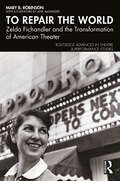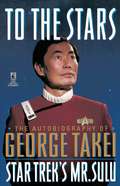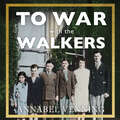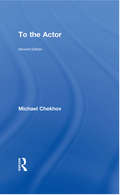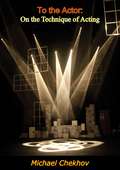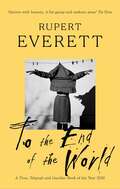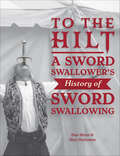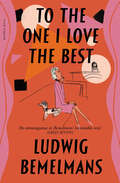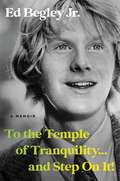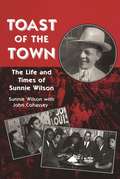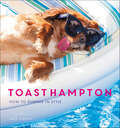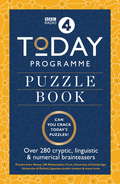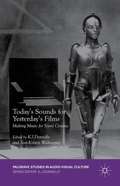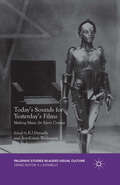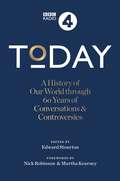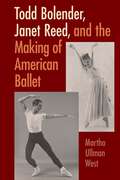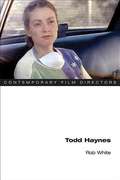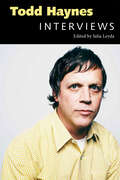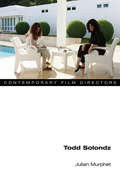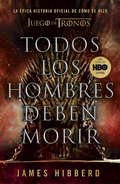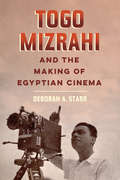- Table View
- List View
To Repair the World: Zelda Fichandler and the Transformation of American Theater (ISSN)
by Mary B. RobinsonThis book is a biography in the form of an oral history about a woman whose founding of Arena Stage in Washington, DC in 1950 shifted live professional theater away from Broadway and inspired the creation of non-profit theaters around the country. Dianne Wiest, James Earl Jones, Stacy Keach, and Jane Alexander, among many others, share their memories of this intrepid pioneering woman during Arena Stage’s early years.As Head of New York University’s Graduate Acting Program for 25 years, Zelda Fichandler also trained a younger generation of gifted actors. Marcia Gay Harden, Rainn Wilson, Mahershala Ali, and other developing actors who became “artist-citizens” under her guidance, talk about the ways in which she transformed their lives.Theater practitioners who have lived during Zelda Fichandler’s time will find this book a fascinating and entertaining read––as will all theater lovers, especially those in Washington, DC. And through this vivid and compelling oral history, students and aspiring artists will come to grasp how the theatrical past can shed essential light on the theater of today and tomorrow.
To The Stars: The Autobiography of George Takei (Star Trek)
by George TakeiBest known as Mr. Sulu, helmsman of the Starship Enterprise™ and captain of the Starship Excelsior, George Takei is beloved by millions as part of the command team that has taken audiences to new vistas of adventure in Star Trek®—the unprecedented television and feature film phenomenon.From the program’s birth in the changing world of the 1960s and death at the hands of the network to its rebirth in the hearts and minds of loyal fans, the Star Trek story has blazed its own path into our recent cultural history, leading to a series of blockbuster feature films and three new versions of Star Trek for television. The Star Trek story is one of boundless hope and crushing disappointment, wrenching rivalries and incredible achievements. It is also the story of how, after nearly thirty years, the cast of characters from a unique but poorly rated television show have come to be known to millions of Americans and people around the world as family. For George Takei, the Star Trek adventure is intertwined with his personal odyssey through adversity in which four-year-old George and his family were forced by the United States government into internment camps during World War II. Star Trek means much more to George Takei than an extraordinary career that has spanned thirty years. For an American whose ideals faced such a severe test, Star Trek represents a shining embodiment of the American Dream—the promise of an optimistic future in which people from all over the world contribute to a common destiny.
To War With the Walkers: One Family's Extraordinary Story of the Second World War
by Annabel Venning'A sensationally good book . . . I see reflections of my own family, and beyond them, like those mirrors tilted slightly into infinity, I can see literally miles of others lined up, inexorably linked forever by a shared experience . . . this is an exceptional book and should be required reading in modern history classes' JOANNA LUMLEY 'An extraordinary, compelling picture of a family entwined in the Second World War . . . at turns funny, sad, redemptive and tragic. Fabulous' JAMES HOLLAND 'A moving book . . . This account of one family's experience takes us to hidden crannies of the war that more official accounts might not bother with . . . Once read, never forgotten' THE TIMES 'Uplifting and enlightening . . . Venning has a good eye for what makes the Walker story both unique and universal' MAIL ON SUNDAY 'Superb . . . With its sweeping narrative, readable style, sense of humanity and breadth of research, the saga casts a highly personal light on some of the most significant episodes of [the Second World War]' DAILY EXPRESS 'A heart-pounding narrative that feels fresh . . . this marvellous book also depicts a world that was soon to vanish' DAILY MAIL 'A loving tribute . . . Brimming with anecdote and rich in fascinating detail' KEGGIE CAREW ~The miraculous story of the Walkers, six siblings who survived Blitz, battle and internment and whose incredible experiences tell a new social history of WW2, told by historian and Walker descendant Annabel Venning. How would it feel if all your sons and daughters were caught up in war? What would it be like to spend six years fearing what a telegram might bring? That was the heart-wrenching reality faced by so many families throughout the Second World War, including the parents of the Walker children. From the Blitz to the battlefields of Europe and the Far East, this is the remarkable story of four brothers and two sisters who were swept along by the momentous events of the war. Harold was a surgeon in a London hospital alongside his sister Ruth, a nurse, when the bombs began to fall in 1940. Peter was captured in the fall of Singapore. Edward fought the Germans in Italy, and Walter the Japanese in Burma, while in London, glamorous Bee hoped for lasting happiness with an American airman. In To War With the Walkers, Annabel Venning, Walter's granddaughter, tells the enthralling and moving tales of her relatives, six ordinary young men and women, who each faced an extraordinary struggle for survival(P) 2019 Hodder & Stoughton Ltd
To the Actor: On the Technique of Acting
by Michael Chekhov Mala PowersMichael Chekhov's classic work To the Actor has been revised and expanded by Mala Powers to explain, clearly and concisely, the essential techniques for every actor from developing a character to strengthen awareness. Chekhov's simple and practical method – successfully used by professional actors all over the world – trains the actor's imagination and body to fulfill its potential. To the Actor includes a previously unpublished chapter on 'Psychological Gesture', translated into English by the celebrated director Andrei Malaev - Babel; a new biographical overview by Mala Powers; and a foreword by Simon Callow. This book is a vital text for actors and directors including acting and theatre history students.
To the Actor: On the Technique of Acting
by Michael Chekov Yul BrynnerIn To the Actor Michael Chekhov has recorded brilliantly the results of his many years of experimenting, testing and verifying in the professional theater and schools of the theater. He brings to actors far greater insight into themselves and the characters they are to portray, which enables them to approach any role with new ease and skill.“To the Actor is by far the best book that I have read on the subject of acting. Actors, directors, writers and critics will be grateful for it. It should prove enlightening to theatergoers who wish to deepen their appreciation for fine acting and thus help to invigorate the theatrical art.”—Gregory Peck“I think without a doubt every creative person in the theater will want to have it as a constant reference book, outside of its being, in my opinion, absorbing and entertaining reading.”—Yul Brynner (from the Preface)“One of the most remarkable and practical books on the technique of acting I have ever read....Enthusiastically recommended to all theatre collections of whatever size.”—Library Journal
To the End of the World: Travels with Oscar Wilde
by Rupert EverettA Times, Telegraph and Guardian Book of the Year 2020 'Quivers with honesty, A-list gossip and sardonic prose' The Times'Everett is a deliciously gifted writer. Nothing and no one escapes his attention' ObserverIn his highly anticipated third memoir, Rupert Everett tells the story of how he set out to make a film of Oscar Wilde's last days, and how that ten-year quest almost destroyed him. (And everyone else.)Travelling across Europe for the film, he weaves in extraordinary tales from his past, remembering wild times, freak encounters and lost friends. There are celebrities, of course. But we also meet glamorous but doomed Aunt Peta, who introduces Rupert (aged three) to the joys of make-up. In '90s Paris, his great friend Lychee burns bright, and is gone. While in '70s London, a 'weirdly tall, beyond size zero' teenage Rupert is expelled from the Central School of Speech and Drama. Unflinchingly honest and hugely entertaining, To the End of the World offers a unique insight into the 'snakes and ladders' of filmmaking. It is also a soulful and thought-provoking autobiography from one of our best-loved and most talented actors and writers.
To the Hilt: A Sword Swallower's History of Sword Swallowing
by Marc Hartzman Dan MeyerTo the Hilt is a riveting exploration into the mysterious and dangerous world of sword swallowing, charting its history from ancient rituals to modern-day performances. Cowritten by world-renowned sword swallower Dan Meyer and celebrated sideshow historian Marc Hartzman, this volume delves into the lives of over 100 sword swallowers. Meyer, with his numerous world records and vast experience, provides an insider&’s perspective that is unmatched, while Hartzman adds depth with his historical knowledge and engaging writing style. Key Features:Definitive compendium of historical biographies: Highlights the captivating lives of historical sword swallowers from the 1700s to the present, many of whom have never been profiled in other books.Behind the scenes with modern performers: Provides an inside look at the wild stories and experiences of modern sword swallowers, who account for one out of every 300 million people alive today.Expert perspectives: Readers will learn from Dan Meyer, the world&’s leading expert on sword swallowing and viral TEDx presenter, as he shares his unique life experiences and relatable life lessons in his introductory essay.Rare imagery: Contains a treasure trove of rare photographs and ephemera that bring the history of sword swallowing to life.Medical insights: Outlines the medical risks and implications of sword swallowing through a doctor&’s essay included in the book, which serves both as a warning and an elucidation of the phenomenon.To the Hilt is a journey into a world where danger and artistry intersect. Perfect for sideshow enthusiasts, history buffs, or those interested in pushing human capability to its limits in any domain, this book will leave readers both enlightened and amazed.
To the One I Love the Best
by Ludwig BemelmansA witty and charming account of the wildly entertaining Elsie de Wolfe in 1950s Hollywood, recounted by her dear friend, the beloved creator of MadelineLudwig Bemelmans&’ charming intergenerational friendship with the late-in-life &“First Lady of Interior Decoration&” provides an enormously enjoyable nostalgia trip to the sun-soaked glamour of Los Angeles, where de Wolfe surrounded herself with classic movie stars and a luminous parade of life's oddities. With hilarity and mischief that de Wolfe would no doubt approve, To the One I Love the Best lifts the curtain on 1950s Hollywood--a bygone world of extravagance and eccentricity, where the parties are held in circus tents and populated by ravishing movie stars. Bemelmans, who was working at MGM, had originally come to the California home of de Wolfe just for cocktails but by the end of the night, he was firmly established as a member of the family: given a bedroom in their sumptuous house, invitations to the most outrageous parties in Hollywood, and the friendship of the larger-than-life woman known to her closest friends simply as 'Mother'. To the One I Love the Best (which refers to de Wolfe&’s dog) is a touching tribute to a fabulously funny woman and an American icon. Be pretty if you can, be witty if you must, but be gracious if it kills you. - Elsie de Wolfe
To the Temple of Tranquility...And Step On It!: A Memoir
by Ed Begley Jr.Beloved actor and environmental activist Ed Begley Jr. shares hilarious and poignant stories of his improbable life, focusing on his relationship with his legendary father, adventures with Hollywood icons, the origins of his environmental activism, addiction and recovery, and his lifelong search for wisdom and common ground. Ed Begley Jr. is truly one of a kind, a performer who is known equally for his prolific film and television career and his environmental activism. From an appearance on My Three Sons to a notable role in Mary Hartman, Mary Hartman to starring in St. Elsewhere—as well as films with Jack Nicholson, Meryl Streep, and mockumentarian Christopher Guest—Begley has worked with just about everyone in Hollywood. His "green" bona fides date back to 1970, and have been the topic of two books, a reality show, countless media appearances, and even repeated spoofs on The Simpsons (in one episode, Begley's solar‑powered car stalls out on train tracks, but is saved when the train is revealed to be an "Ed Begley Solar‑Powered Train&”). In To the Temple of Tranquility...And Step On It!, Begley shares a fountain of hilarious and poignant stories throughout his life. The memoir is candid and endearing; in one chapter, he is summoned to Marlon Brando's house to discuss the practical uses of electric eels. In another, he tells the story of taking Annette Bening to the Oscars in &“an oddball kit-car that had gull wing doors, and was nearly impossible to get in or out of, unless you were a yoga master, which fortunately she was.&” Not to mention insightful and surprising tales about The Beatles, Monty Python, Richard Pryor, Cesar Chavez, Jeff Goldblum, Tom Waits, Arnold Schwarzenegger, Carrie Fisher, and so many more luminaries. Begley&’s unmistakable voice is honest and revealing in a way that only a comic of his caliber can accomplish. Behind all the stories, Begley has wisdom to impart. This is a book about family, friends, addiction, failure, and redemption.
Toast of the Town: The Life and Times of Sunnie Wilson (Great Lakes Books Series)
by Sunnie Wilson John CohasseyToastHampton: How to Summer in Style
by Katie SturinoA delightful and colorful high-fashion romp featuring Toast, the world’s first supermodel dog.She’s graced the pages of the New York Times and Us Weekly, and has appeared on Good Morning America and the Today show. She’s starred in designer Karen Walker’s advertising campaign, and pens her own weekly column in PeopleMagazine: Pets. Her jet-setting friends include Karlie Kloss, Reese Witherspoon, Jane Lynch, and, of course, her Internet celebrity dad, The Fat Jew. She has hundreds of thousands of fans following her every move on Instagram. She’s Toast, the puppymill rescue Cavalier King Charles Spaniel whose toothless grin and ever-present tongue have become today’s hottest style sensation.Now, fans can enjoy their favorite fashionista canine in ToastHampton, a collection of divine photographs that capture Toast shaking her auburn fur as she models big-name brands in the tony Hamptons.Whether she’s lounging on the sand, frolicking through a seaside meadow, dipping her paws in the sparkling sea, or striking one of her famous poses, Toast always sports the unique, sophisticated style that has melted fans’ hearts worldwide . . . and keeps them begging for more.
Today Programme Puzzle Book: The puzzle book of 2018
by BBC***The best intelligent puzzle book on the market*** Fiendish fun! - The Times Can YOU solve the Puzzle for Today?Tackle the conundrums that have been frustrating and confounding the nation, with the first official book from Radio 4's Today programme.Put your deciphering skills and mental agility to the test with over 280 cryptic, numerical and linguistic brainteasers from Britain's best-loved radio programme, set by the world's ultimate puzzle masters.So, challenge your grey matter and hone your reasoning and logic skills with the brainteasers that get the nation's (and many world leaders') synapses firing every morning at 6.50am.With a foreword by Sarah Sands, editor of the Today programme.Introductions to each chapter by Tom Feildon, the BBC Science Editor.Chapters:Never Aired Puzzles Common-sense ConundrumsFlags, Capitals & NationsMaths & LanguageFurther MathsBBC Today Presenters' PuzzlesCelebrity SettersChristmas Crackers Want to take on the hardest, most fiendish puzzles out there created by the greatest minds around the world? If The Ordnance Survey Puzzle Book, The GCHQ Puzzle Book and Tim Peake's Astronaut Selection Test Book were no match for you, pit your wit against TODAY.
Today Programme Puzzle Book: The puzzle book of 2018
by Bbc***The puzzle book of 2018***The Today Programme Puzzle Book is perfect for fans of Bletchley Park Brainteasers and The GCHQ Puzzle Book. Which is the only letter of the alphabet not to appear in the name of any US state? Can YOU solve the Puzzle for Today?Tackle the conundrums that have been frustrating and confounding the nation on Radio 4's Today programme.The Today Programme Puzzle Book challenges you with over 280 cryptic, linguistic & numerical brainteasers designed by the greatest puzzles masters around the world from Mensa, UK Mathematics Trust, University of Cambridge, University of Oxford, Japanese puzzle masters & many more.Chapters include:Common-sense ConundrumsFlags, Capitals & NationsMaths & LanguageFurther MathsNew PuzzlesBBC Today Presenters' PuzzlesCelebrity SettersChristmas CrackersSo, challenge your grey matter and hone your reasoning and logic skills with the brainteasers that manage to get the nation's synapses firing every morning. With a foreword by Sarah Sands, editor of the Today programme.Introductions to each chapter by Tom Feildon, the BBC Science Editor.[Answer: The letter Q]
Today's Sounds for Yesterday's Films: Making Music for Silent Cinema (Palgrave Studies in Audio-Visual Culture)
by K. J. Donnelly Ann-Kristin WallengrenIn recent years, there has been something of an explosion in the performance of live music to silent films. There is a wide range of films with live and new scores that run from the historically accurate orchestral scores to contemporary sounds by groups such as Pet Shop Boys or by experimental composers and gothic heavy metal bands. It is no exaggeration to claim that music constitutes a bridge between the old silent film and the modern audience; music is also a channel for non-scholarly audiences to gain an appreciation of silent films. Music has become a means both for musicians and audiences to understand this bygone film art anew. This book is the first of its kind in that it aims to bring together writings and interviews to delineate the culture of providing music for silent films. It not only has the character of a scholarly work but is also something of a manual in that it discusses how to make music for silent films.
Today's Sounds for Yesterday's Films: Making Music for Silent Cinema (Palgrave Studies in Audio-Visual Culture)
by K. J. Donnelly Ann-Kristin WallengrenIn recent years, there has been something of an explosion in the performance of live music to silent films. There is a wide range of films with live and new scores that run from the historically accurate orchestral scores to contemporary sounds by groups such as Pet Shop Boys or by experimental composers and gothic heavy metal bands. It is no exaggeration to claim that music constitutes a bridge between the old silent film and the modern audience; music is also a channel for non-scholarly audiences to gain an appreciation of silent films. Music has become a means both for musicians and audiences to understand this bygone film art anew. This book is the first of its kind in that it aims to bring together writings and interviews to delineate the culture of providing music for silent films. It not only has the character of a scholarly work but is also something of a manual in that it discusses how to make music for silent films.
Today: A History of our World through 60 years of Conversations & Controversies
by Edward StourtonEdited by Edward StourtonForewords by Nick Robinson & Martha KearneyWith an introduction by Sarah Sands, editor of the Today programme.In an era of fake news, echo chambers and new fault lines in global politics, millions of listeners turn to BBC Radio 4's Today programme each morning to help them make sense of the world around them. The first ever book from the iconic programme marks six decades of BBC Radio 4's Today programme with sixty world changing stories as they were broadcast. Covering war, rebellion and political transformation, to significant changes in culture, society, and the scientific world, the book explores events as they happened, and how they changed the world around us.From the fall of the Berlin Wall and the anti-apartheid movement to 9/11 and the Rise of Islamic State, from the Rushdie affair to the emergence of Brit Art and from space exploration to the tomorrow's world of artificial intelligence and machine learning. Key figures within the book include Harold Wilson, Margaret Thatcher, Stephen Hawking, Tracey Emin and Barack Obama. Chapters include:Chapter 1: Rebellion, Revolution and ProtestChapter 2: Britain's Political LandscapeChapter 3: War, Conflict and SecurityChapter 4: Art, Culture and SportChapter 5: Social ChangeChapter 6: The Natural World, Science and TechnologyToday is the sound of history being made - live on air.Also available in Audio and Ebook.
Today: A History of our World through 60 years of Conversations & Controversies
by Sarah SandsToday is the sound of history being made - live on air.In an era of fake news, echo chambers and new fault lines in global politics, millions of listeners turn to BBC Radio 4's Today programme each morning to help them make sense of the world around them. The first ever book from the iconic programme marks six decades of BBC Radio 4's Today programme with sixty world changing stories as they were broadcast. Covering war, rebellion and political transformation, to significant changes in culture, society, and the scientific world, the book explores events as they happened, and how they changed the world around us.From the fall of the Berlin Wall and the anti-apartheid movement to 9/11 and the Rise of Islamic State, from the Rushdie affair to the emergence of Brit Art and from space exploration to the tomorrow's world of artificial intelligence and machine learning. Key figures within the book include Harold Wilson, Margaret Thatcher, Stephen Hawking, Tracey Emin and Barack Obama. Chapters include:Chapter 1: Rebellion, Revolution and ProtestChapter 2: Britain's Political LandscapeChapter 3: War, Conflict and SecurityChapter 4: Art, Culture and SportChapter 5: Social ChangeChapter 6: The Natural World, Science and TechnologyAlso available in Audio and Ebook.Edited by Edward StourtonForewords by Nick Robinson & Martha KearneyWith an introduction by Sarah Sands, editor of the Today programme.Shortlisted for the 2019 FutureBook of the Year award
Today: A History of our World through 60 years of Conversations & Controversies
by Sarah SandsToday is the sound of history being made - live on air.In an era of fake news, echo chambers and new fault lines in global politics, millions of listeners turn to BBC Radio 4's Today programme each morning to help them make sense of the world around them. The first ever book from the iconic programme marks six decades of BBC Radio 4's Today programme with sixty world changing stories as they were broadcast. Covering war, rebellion and political transformation, to significant changes in culture, society, and the scientific world, the book explores events as they happened, and how they changed the world around us.From the fall of the Berlin Wall and the anti-apartheid movement to 9/11 and the Rise of Islamic State, from the Rushdie affair to the emergence of Brit Art and from space exploration to the tomorrow's world of artificial intelligence and machine learning. Key figures within the book include Harold Wilson, Margaret Thatcher, Stephen Hawking, Tracey Emin and Barack Obama. Chapters include:Chapter 1: Rebellion, Revolution and ProtestChapter 2: Britain's Political LandscapeChapter 3: War, Conflict and SecurityChapter 4: Art, Culture and SportChapter 5: Social ChangeChapter 6: The Natural World, Science and TechnologyAlso available in Audio and Ebook.Edited by Edward StourtonForewords by Nick Robinson & Martha KearneyWith an introduction by Sarah Sands, editor of the Today programme.Shortlisted for the 2019 FutureBook of the Year award
Todd Bolender, Janet Reed, and the Making of American Ballet
by Martha WestMartha Ullman West illustrates how American ballet developed over the course of the twentieth century from an aesthetic originating in the courts of Europe into a stylistically diverse expression of a democratic culture. West places at center stage two artists who were instrumental to this story: Todd Bolender and Janet Reed. Lifelong friends, Bolender (1914–2006) and Reed (1916–2000) were part of a generation of dancers who navigated the Great Depression, World War II, and the vibrant cultural scene of postwar New York City. They danced in the works of choreographers Lew and Willam Christensen, Eugene Loring, Agnes de Mille, Catherine Littlefield, Ruthanna Boris, and others who West argues were just as responsible for the direction of American ballet as the legendary George Balanchine and Jerome Robbins. The stories of Bolender, Reed, and their contemporaries also demonstrate that the flowering of American ballet was not simply a New York phenomenon. West includes little-known details about how Bolender and Reed laid the foundations for Seattle’s Pacific Northwest Ballet in the 1970s and how Bolender transformed the Kansas City Ballet into a highly respected professional company soon after. Passionate in their desire to dance and create dances, Bolender and Reed committed their lives to passing along their hard-won knowledge, training, and work. This book celebrates two unsung trailblazers who were pivotal to the establishment of ballet in America from one coast to the other.
Todd Haynes (Contemporary Film Directors)
by Rob WhiteTodd Haynes's films are intricate and purposeful, combining the intellectual impact of art cinema with the emotional accessibility of popular genres. They are also underpinned by a serious commitment to feminism and queer theory. From his 1985 student film about Arthur Rimbaud to his shapeshifting portrait of Bob Dylan in I'm Not There (2007) and the riveting HBO miniseries Mildred Pierce (2011), Haynes has made films whose complex weave of stories and characters reveals dark, painful intensities. His taste for narrative experimentation and pastiche is haunted by anguish. Rob White's highly readable book, which includes a major new interview with Haynes, is the first comprehensive study of the director's work. Special attention is paid to the fascination with music culture (from the Carpenters to glam rock) and to the rich pattern of allusions to, or affinity with, predecessor filmmakers (Fassbinder, Ophuls, Sirk, and many more). But White's chief concern is the persistence of a queer impulse to explore social coercion and the possibility that there may be some way of escaping its cruelty.
Todd Haynes: Interviews (Conversations with Filmmakers Series)
by Julia LeydaA pioneer of the New Queer Cinema, Todd Haynes (b. 1961) is a leading American independent filmmaker. Whether working with talking dolls in a homemade short (Superstar: The Karen Carpenter Story) or with Oscar-winning performers in an HBO miniseries (Mildred Pierce), Haynes has garnered numerous awards and nominations and an expanding fan base for his provocative and engaging work. In all his films, Haynes works to portray the struggles of characters in conflict with the norms of society. Many of his movies focus on female characters, drawing inspiration from genres such as the woman's film and the disease movie (Far from Heaven and Safe); others explore male characters who transgress sexual and other social conventions (Poison and Velvet Goldmine). The writer-director has drawn on figures such as Karen Carpenter, David Bowie, Iggy Pop, and Bob Dylan in his meditations on American and British music, celebrity, and the meaning of identity. His 2007 movie I'm Not There won a number of awards and was notable for Haynes's decision to cast six different actors (one of whom was a woman) to portray Dylan. Gathering interviews from 1989 through 2012, this collection presents a range of themes, films, and moments in the burgeoning career of Todd Haynes.
Todd Solondz (Contemporary Film Directors)
by Julian MurphetFilms like Welcome to the Dollhouse and Happiness established Todd Solondz as independent cinema's premier satirist. Blending a trademark black humor into atmospheres of grueling bleakness, Solondz repeatedly takes moviegoers into a bland suburban junk space peopled by the damaged, the neglected, and the depraved.Julian Murphet appraises the career of the controversial, if increasingly ignored, indie film auteur. Through close readings and a discussion with the director, Murphet dissects how Solondz's themes and techniques serve stories laden with hot-button topics like pedophilia, rape, and family and systemic cruelty. Solondz's uncompromising return to the same motifs, stylistic choices, and characters reject any idea of aesthetic progression. Instead, he embraces an art of diminishing returns that satirizes the laws of valuation sustaining what we call cinema. It also reflects both Solondz's declining box office fortunes and the changing economics of independent film in an era of financial contraction.
Todos los hombres deben morir: La épica historia oficial de cómo se hizo Juego de tronos
by James HibberdLa épica historia oficial, avalada por HBO, de cómo se hizo la exitosa serie de televisión Juego de tronos. «Todo está aquí: cómo comenzó, cómo terminó, dragones y lobos huargos, lo que pasó delante de las cámaras y entre bambalinas, los triunfos y tropiezos, las decisiones difíciles, las encrucijadas, los porqués. Actores, directores, showrunners, productores, ejecutivos e incluso a mí... Todos los hombres deben morir lo tiene todo, todo lo que siempre has querido saber. Juego de tronos fue un viaje apasionante. Todos los hombres deben morir es una lectura apasionante.» George R.R. Martin Se suponía que era imposible. Cuando George R. R. Martin creó su saga best seller de novelas fantásticas titulada «Canción de hielo y fuego», lo hizo con la idea de confinarla únicamente a los inmensos límites de su imaginación dada la dificultad que conllevaría el rodaje. Sin embargo, un par de guionistas primerizos, junto con HBO, lograron adaptar el épico relato de Martin y el resultado es de sobras conocido: muchos hemos visto las ocho temporadas de la galardonada serie que llegaron a continuación. A pesar del éxito, siempre bien documentado, todavía nos queda una historia por conocer sobre Juego de tronos: los entresijos de los trece años de lucha para sacar adelante este extraordinario fenómeno. En Todos los hombres deben morir, el premiado periodista James Hibberd nos ofrece, por primera vez y en exclusiva, la crónica de la aclamadísima serie de HBO Juego de tronos: desde la reunión inicial del equipo creativo hasta la puesta en escena del final de la serie, pasando por todas las épicas batallas que se libraron delante y detrás de las cámaras y que también se convirtieron en leyenda. Este esperado libro contiene más de cincuenta entrevistas inéditas y fotos espectaculareso poco conocidas del rodaje. Además, nos da acceso a la increíble experiencia de los productores, el reparto y el equipo que consiguió convertir las novelas de George R. R. Martin en el mayor fenómeno televisivo del mundo.
Toes
by Tor SeidlerAfter getting lost on Halloween night when he is only a few months old, an intelligent seven-toed kitten makes his way into the life of a struggling musician.
Togo Mizrahi and the Making of Egyptian Cinema (University of California Series in Jewish History and Cultures #1)
by Prof. Deborah A. StarrA free open access ebook is available upon publication. Learn more at www.luminosoa.org. In this book, Deborah A. Starr recuperates the work of Togo Mizrahi, a pioneer of Egyptian cinema. Mizrahi, an Egyptian Jew with Italian nationality, established himself as a prolific director of popular comedies and musicals in the 1930s and 1940s. As a studio owner and producer, Mizrahi promoted the idea that developing a local cinema industry was a project of national importance. Togo Mizrahi and the Making of Egyptian Cinema integrates film analysis with film history to tease out the cultural and political implications of Mizrahi’s work. His movies, Starr argues, subvert dominant notions of race, gender, and nationality through their playful—and queer—use of masquerade and mistaken identity. Taken together, Mizrahi’s films offer a hopeful vision of a pluralist Egypt. By reevaluating Mizrahi’s contributions to Egyptian culture, Starr challenges readers to reconsider the debates over who is Egyptian and what constitutes national cinema.
